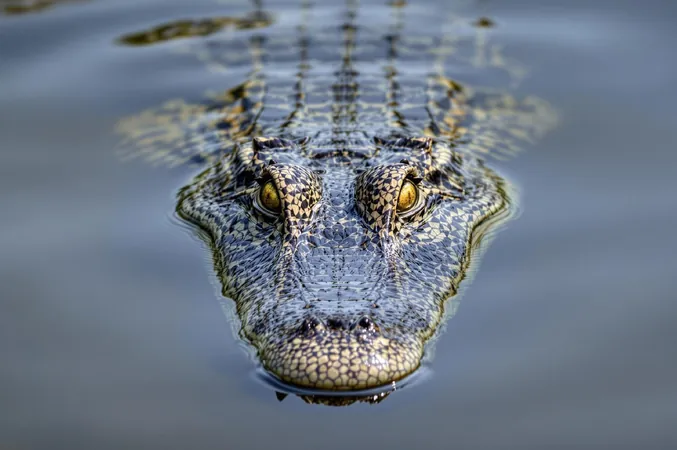
How Crocodiles Outlasted Earth's Great Extinctions: A Tale of Survival and Adaptation
2025-04-18
Author: Wei Ling
A Journey Through Time: The Resilient Crocodile
When you picture crocodiles, images of ancient relics and lurking predators often come to mind. Yet, their survival narrative is a fascinating tale of resilience and adaptability. New research from the University of Central Oklahoma and the University of Utah reveals that crocodiles have not merely survived for millions of years; they've evolved to thrive through two major mass extinctions.
The Secret to Their Survival
Crocodylians, which include today's crocodiles, alligators, and gharials, are the last representatives of a lineage that stretches back 230 million years. Their ancient relatives inhabited diverse ecosystems but faced extinction while these adaptable survivors endured.
Lead author Keegan Melstrom notes, "Extinction and survivorship are two sides of the same coin. Studying the patterns of those that persisted can provide insights into today’s environmental challenges." With scientists warning of a sixth mass extinction, understanding how species like crocodiles have thrived could hold crucial lessons for current wildlife preservation efforts.
Crocodilians vs. Mammals: Unfair Comparisons?
Traditionally, mammals have hogged the spotlight in extinction studies, benefiting from their diverse diets. However, this new research shines a light on crocodiles, challenging the notion of their insignificance in the extinction survival conversation. Co-author Randy Irmis cautions, "We must be careful in directly applying ancient lessons to modern conservation, but the possibility emerges that species with generalist diets might fare better in changing climates."
A Glimpse into Their Past
Modern crocodylians are infamous for their aquatic lifestyles and voracious appetites. Yet, their ancestors were primarily land-dwelling predators that evolved through shifting ecological landscapes. The end-Triassic extinction marked a pivotal moment, allowing crocodylomorphs with versatile diets to flourish while other dominant reptile groups vanished.
Melstrom enthusiastically remarks, "After that mass extinction event, crocodylomorphs evolved into myriad forms—some adapted to land, others returning to water, and a few becoming hypercarnivores. Their adaptability has allowed them to thrive across diverse ecosystems throughout history."
Unlocking the Evolutionary Mysteries
To unravel the dietary habits of these ancient creatures, researchers meticulously studied fossilized teeth and skulls, revealing insights into their dietary adaptations. Their extensive study included nearly 100 extinct species and several living ones, showcasing an evolutionary journey spanning over 230 million years.
From swift terrestrial hunters to aquatic grazers, these adaptations highlight how today's crocodiles are merely the tip of the iceberg in a vast evolutionary history.
Future Outlook: Can Crocodiles Withstand Change?
While many contemporary crocodiles continue to thrive, several species, like the endangered gharial and the Cuban crocodile, face significant threats. Their survival may hinge on their ancient ability to adapt, stressing the importance of preserving their habitats.
Irmis reflects, "When we encounter crocodiles today, let’s look beyond their fierce reputation and appreciate their incredible evolutionary journey that has allowed them to endure various global upheavals. Crocodylians possess the tools to face future challenges—if only we commit to safeguarding their environments."
Conclusion: A Legacy Worth Preserving
This landmark study, available in the journal Palaeontology, underscores the evolutionary significance of crocodiles and serves as a clarion call for conservation efforts. In safeguarding these ancient creatures, we also protect a vital chapter in Earth’s enduring narrative.




 Brasil (PT)
Brasil (PT)
 Canada (EN)
Canada (EN)
 Chile (ES)
Chile (ES)
 Česko (CS)
Česko (CS)
 대한민국 (KO)
대한민국 (KO)
 España (ES)
España (ES)
 France (FR)
France (FR)
 Hong Kong (EN)
Hong Kong (EN)
 Italia (IT)
Italia (IT)
 日本 (JA)
日本 (JA)
 Magyarország (HU)
Magyarország (HU)
 Norge (NO)
Norge (NO)
 Polska (PL)
Polska (PL)
 Schweiz (DE)
Schweiz (DE)
 Singapore (EN)
Singapore (EN)
 Sverige (SV)
Sverige (SV)
 Suomi (FI)
Suomi (FI)
 Türkiye (TR)
Türkiye (TR)
 الإمارات العربية المتحدة (AR)
الإمارات العربية المتحدة (AR)